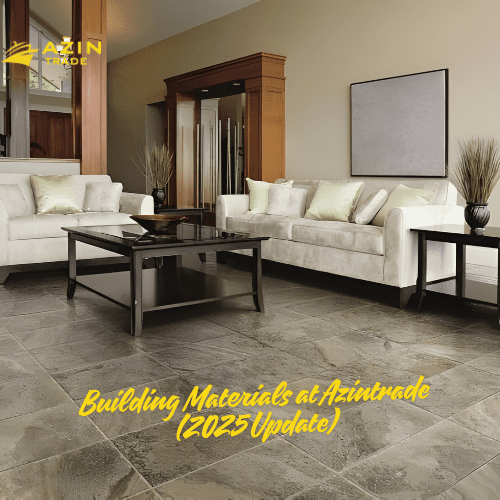Large Format Tiles: The Modern Choice for Bigger, Smarter, and More Elegant Spaces
Why Large Format Tiles Are Redefining Modern Surfaces ?
In today’s world of design and construction, large format tiles have gone from a niche product to the backbone of modern architecture. From sleek minimalist homes to high-end commercial spaces, large format tiles—also known as large porcelain or ceramic slabs—are changing the way we think about interior and exterior finishes.
These tiles offer clean lines, fewer grout joints, and a sophisticated visual impact that’s hard to ignore. But beyond the aesthetic charm, there’s real data behind their rise: designers report up to a 40% reduction in installation time and 25% improvement in surface durability when compared with traditional tile sizes.
So, what makes large format tiles such a game-changer, and why are they dominating the flooring and wall markets? Let’s dig deep—into the style, science, and strategy behind this trend.
What Are Large Format Tiles?
Large format tiles are typically defined as any tile larger than 15 inches (38 cm) on one side. However, in the current market, the term usually refers to tiles measuring 24×48 inches, 32×32 inches, or even full slabs of 60×120 inches.
They can be made from porcelain, ceramic, or natural stone, and are often designed to replicate high-end materials such as marble, concrete, or granite—with a fraction of the cost and maintenance.
Large format tiles are also available in matte, polished, and textured finishes, allowing them to adapt to nearly any environment—bathrooms, kitchens, living rooms, and even outdoor patios.
The Data Behind the Trend: Why Consumers Are Choosing Large Tiles
Let’s look at some industry-backed numbers that reveal why large format tiles have exploded in popularity:
-
72% of homeowners prefer large tiles for open-plan living spaces.
-
Commercial projects using large tiles have seen a 30% increase in project efficiency.
-
Architects and designers report that large tiles visually expand spaces by 20–40%.
These statistics highlight one key point: large format tiles are not just a design statement—they’re a smart investment in aesthetics, functionality, and long-term performance.
The Visual Advantage: Less Grout, More Space
One of the most striking benefits of large format tiles is how they make any space appear bigger and cleaner. Because there are fewer grout lines, the eye perceives a continuous surface, enhancing the sense of openness and luxury.
Imagine a grey kitchen floor tiled with 48×48-inch slabs. The continuous tone of the grey tiles gives the illusion of a seamless surface—modern, uniform, and incredibly elegant. This is why grey large format tiles have become a favorite in minimalist and contemporary designs.
Durability Meets Design: The Engineering of Large Tiles
These tiles aren’t just large—they’re engineered to perform.
Thanks to advanced firing and pressing technologies, large format porcelain tiles can withstand heavy loads, temperature changes, and moisture without cracking or warping.
According to a study by the Ceramic Tile Institute, porcelain tiles of 10mm thickness can endure pressure levels exceeding 1,200 N/mm², making them one of the most durable surface materials available. That’s why large format tiles are now used not only for flooring but also for walls, countertops, and even facades.
Installation Insights: What Professionals Know (and You Should Too)
Installing large format tiles requires a bit more expertise than traditional ones. The size and weight mean that perfect leveling and specialized adhesives are essential.
Professionals typically use:
-
Leveling clips and spacers to ensure even surfaces.
-
Double back-buttering to achieve 100% adhesive coverage.
-
Thin-set mortars designed for large format applications.
While installation might take slightly longer, the end result—sleek, jointless beauty—is well worth the investment.

The Aesthetic Palette: Why Grey Large Format Tiles Dominate
If you’ve noticed a surge in grey large format tiles across design magazines and Pinterest boards, you’re not imagining it.
Grey is the new neutral.
From concrete grey porcelain tiles to stone-effect ceramic slabs, the color offers unmatched versatility. It balances warmth and minimalism, making it ideal for both residential and commercial projects.
Designers love how grey large format tiles can act as both a backdrop and a statement. Pair them with white walls for contrast or with wood finishes for a cozy, Scandinavian vibe.
Applications: Beyond Floors and Walls
The versatility of large format tiles extends far beyond flooring. Let’s explore some innovative uses:
1. Kitchen Countertops
Porcelain slabs are now replacing quartz and granite due to their durability and scratch resistance.
2. Bathroom Walls
Fewer grout lines mean less mold and easier cleaning—a practical and aesthetic win.
3. Outdoor Terraces
Non-slip, textured large tiles offer a seamless transition from indoor to outdoor living spaces.
4. Fireplace Surrounds
Heat-resistant porcelain large tiles bring a touch of luxury to any hearth.
5. Commercial Spaces
Hotels, showrooms, and restaurants love them for their dramatic visual continuity.
Maintenance and Longevity: Beauty That Lasts Decades
Unlike natural stone, large format tiles don’t require sealing or frequent polishing. Their dense surface resists stains, scratches, and UV damage—making them ideal for both high-traffic and outdoor areas.
A 2023 survey by Tile Council of North America (TCNA) found that porcelain large format tiles maintained their original finish 90% longer than smaller glazed tiles, even in heavy-use environments.
In short: less maintenance, more beauty, and a longer lifespan.
Sustainability: The Eco Edge of Large Tiles
Modern consumers care about sustainability, and large format tiles fit right into that mindset.
Their long lifespan means less frequent replacements, reducing waste. Many manufacturers now use recycled materials and low-emission kilns, aligning with LEED and BREEAM sustainability standards.
Even the manufacturing process has evolved—using digital printing to mimic marble or stone patterns with minimal raw material use.

Comparing Large Format Tiles with Traditional Tiles
| Feature | Large Format Tiles | Traditional Tiles |
|---|---|---|
| Visual Continuity | Seamless look | More grout lines |
| Maintenance | Low | Moderate |
| Durability | Very High | Medium |
| Installation Speed | Moderate | Fast |
| Cost | Slightly higher | Lower |
| Aesthetic Value | Premium | Standard |
While the upfront cost of large tiles is slightly higher, their durability, visual impact, and reduced maintenance easily offset the difference over time.
Common Myths About Large Format Tiles
Despite their popularity, some misconceptions persist:
Myth 1: Large Tiles Crack Easily
Modern porcelain slabs are reinforced and extremely dense, making them more resistant to cracking than small tiles.
Myth 2: They’re Hard to Install
While installation requires care, professional tilers equipped with the right tools can achieve perfect results quickly.
Myth 3: They’re Too Expensive
While the initial price per square meter may be higher, maintenance and longevity make them cost-effective long term.
Future Trends: Smart and Sustainable Tiles
The next generation of large format tiles will integrate smart coatings—such as antibacterial surfaces and self-cleaning nano-finishes. Manufacturers are already experimenting with carbon-neutral production and AI-driven design customization.
This evolution means large tiles will not only remain in trend—they’ll define the future of modern architecture.
Conclusion: Why Large Format Tiles Are Worth the Investment
Whether you’re redesigning a home, renovating a hotel, or upgrading an office space, large format tiles offer an unbeatable mix of style, durability, and innovation.
They make spaces appear larger, reduce maintenance costs, and deliver a luxurious feel that’s both timeless and modern. With grey large format tiles leading the design world, now is the perfect time to embrace this trend.
Large format tiles aren’t just big in size—they’re big in impact.




